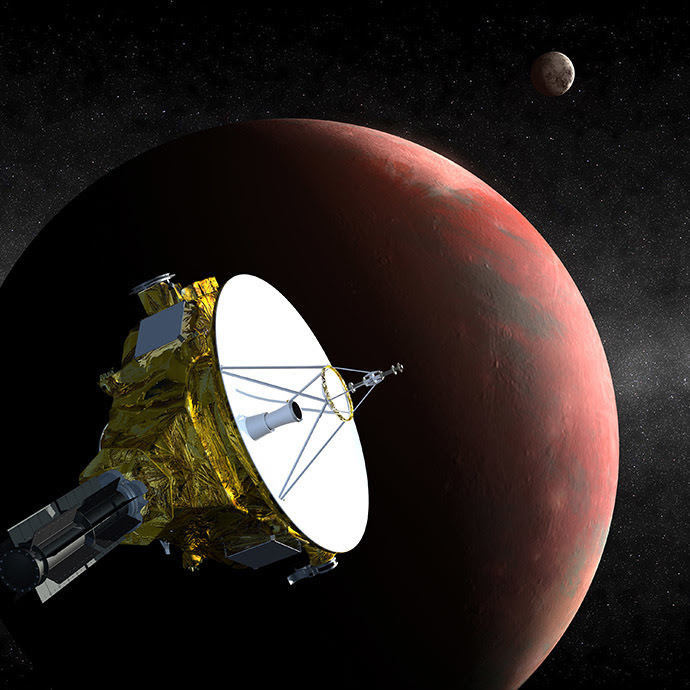NASA Pluto probe wakes up after 9-year slumber in space
Published time: December 07, 2014 06:57
Edited time: December 07, 2014 02:59

This artist's concept obtained December 1, 2014 courtesy of NASA/Johns Hopkins University Applied Physics Laboratory/Southwest Research Institute (JHUAPL/SwRI), shows the New Horizons spacecraft as it approaches Pluto and its three moons in summer 2015. (AFP/NASA)
The New Horizons spacecraft has come out of hibernation mode in anticipation of rendezvous with Pluto and its moons. The spacecraft will be exploring the Solar System’s most famous dwarf planet for six months starting the observation phase in January.
The New Horizons' onboard computer was programmed in August during its latest system check to make a “wake-up call” on December 6, at 3 PM. Some 90 minutes later, it sent a signal to control center on Earth, informing that it is in ‘active’ mode.
It took 4 hours and 25 minutes for the signal to cover 4.7 billion kilometers and reach the mission operations team at Applied Physics Laboratory at Johns Hopkins University (JHU), where the New Horizons was designed and manufactured.
At the moment the probe is a ‘mere’ 260 million kilometers from Pluto.
"We've worked years to prepare for this moment,” said Mark Holdridge, New Horizons encounter mission manager at APL, asquoted by the University’s HUB news network.
“New Horizons might have spent most of its cruise time across nearly three billion miles of space sleeping, but our team has done anything but, conducting a flawless flight past Jupiter just a year after launch, putting the spacecraft through annual workouts, plotting out each step of the Pluto flyby and even practicing the entire Pluto encounter on the spacecraft. We are ready to go."
The current wake-up has become the 18th for the New Horizons, from mid-2007 to late 2014. The probe spent in hibernation about two-thirds of its flight time, most of it after its fly-by of Jupiter in February 2007.
Hibernation mode, when almost all systems aboard are unpowered, helps preserve energy and systems wear. The sleeping periods lasted between 36 and 202 days. At least twice a year the probe was awakened for systems check, instrument calibration and course correction. Otherwise the only signals coming from the New Horizons were weekly beacon beeps.

The Atlas V rocket with the New Horizons spacecraft blasts off from complex 41 at the Cape Canaveral Air Force Station in Cape Canaveral. (Reuters/Rick Fowler)
Launched by an Atlas V rocket booster on January 19, 2006, the 478 kilogram piano-sized spacecraft is expected to make its closest approach to the dwarf planet on July 14, when the New Horizons will pass at only 10,000 kilometer distance.
On January 15, the probe will start distant observations of the Pluto system which will continue until late July 2015.
For the next six weeks the New Horizons will be getting prepared for the job.
Scientists will be checking probe’s memory, navigation and other systems, communication equipment, sensors and cameras.

This artist's concept obtained December 1, 2014 courtesy of NASA/Johns Hopkins University Applied Physics Laboratory/Southwest Research Institute (JHUAPL/SwRI), shows the New Horizons spacecraft as it approaches Pluto and its three moons in summer 2015. (AFP Photo/NASA/Johns Hopkins University Applied Physics Laboratory/Southwest Research Institute)
The probe has seven scientific instruments aboard, which include advanced imaging infrared and ultraviolet spectrometers, a compact multicolor camera, a high-resolution telescopic camera, two powerful particle spectrometers and a space-dust detector.
All this payload as well as telecommunication equipment, flight computer and other systems are powered by a single radioisotope thermoelectric generator. The spacecraft consumes less electricity than two 100-watt light bulbs, but that is enough to get the job done and beam data to Earth.
Apart from making high resolution photos, the probe will explore Pluto’s atmosphere and the way it interacts with the Sun.
The mission is set to gather information about geology and topography of Pluto and its large moon Charon, measuring and mapping their surface temperatures and compositions, and studying Pluto’s smaller moons. The probe is also going to search for new moons and possible rings.
“This is the first look at this new zone of rocky, icy planets,” Michael Buckley, a public information officer for John Hopkins University Applied Physics Laboratory told ABC News. “This is what New Horizons is supposed to do.”

NASA's New Horizons spacecraft, to be launched toward the planet Pluto, is displayed at the Kennedy Space Center in Cape Canaveral, Florida. (Reuters/Charles W Luzier)
The spacecraft will finally give exact measurements of Pluto’s size, which were difficult to ascertain from a greater distance due to its atmosphere. So space scientists will be able to tell whether Pluto is bigger or smaller than Eris, another dwarf planet, the discovery of which in 2005 led to Pluto’s demotion from a regular planet to a dwarf one.
New Horizons’ post-Pluto mission is expected to include the study of other Kuiper belt objects. It is to end in 2026, but may be extended into 2030s, if the spacecraft remains operational at that time.









No comments:
Post a Comment